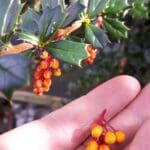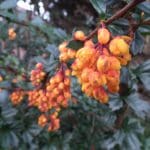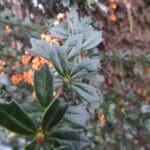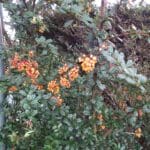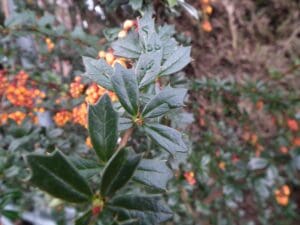Darwins Barberry / Spring / Summer / Autumn / Edible
Common Names
Darwins Barberry
Botanical Name
Berberis darwinii
Scientific Classification
Kingdom – Plantae
Order –Ranunculales
Family – Berberidaceae
Physical Characteristics for Darwins Barberry
It is an evergreen thorny shrub growing to 3–4 m tall, with dense branches from ground level. It is hardy to zone (UK) 7 and is not frost tender.
Leaves
The leaves are small oval, 12–25 mm long and 5–12 mm broad, with a spiny margin; they are borne in clusters of 2–5 together, subtended by a three-branched spine 2–4 mm long. In leaf from December to January onwards, they look a bit like small Holly leaves but with fewer spikes.
Flowers
The flowers are orange, 4–5 mm long, produced in dense racemes 2–7 cm long in spring. The flowers are hermaphrodite (have both male and female organs) and are pollinated by Insects, and self.The plant is self-fertile.
Fruit
The fruit is a small purple-black berry 4–7 mm diameter, ripening in summer.
Habitat
Native to southern Chile and Argentina and naturalised elsewhere. Moist shady woodland in the Patagonian mountains. Woodland Garden Dappled Shade; Shady Edge; Hedge;
Known Hazards
None known.
Could be Confused with
Other members of the Berberris family, none of which are harmful.
Edible Uses
The flowers are edible and pack a sweet, yet citrus punch. The berries are also edible, but can be quite acidic. When fully ripe, the fruit loses most of its acidity and makes very pleasant eating. Unfortunately there is a lot of seed compared to the amount of flesh and this does detract somewhat from the pleasure of eating it. The fruit goes very well raw in a muesli or cooked in a porridge. The fruits are about 7mm long.
Flowers are available in spring and taste sweetest on sunny days. The fruit are fully ripe from about July to August and can taste quite sweet, but have a lot of seeds inside.
Notes on Herbal uses
The root bark is tonic. Berberine, universally present in all parts of Berberis species but especially the rhizomes, has marked antibacterial effects, especially upon the urinary system. Since it is not appreciably absorbed by the body, it is used orally in the treatment of various enteric infections, especially bacterial dysentery. It should not be used with Glycyrrhiza species (Liquorice) because this nullifies the effects of the berberine. Berberine has also shown anti-tumour activity.
Extra notes from the Foragers
Berberis darwinii was discovered (in Western science) in South America in 1835 by Charles Darwin during the voyage of the ‘Beagle’; however, the berries of this species were consumed by prehistoric native peoples in the Patagonian region over millennia. The species was one of many named in honour of Darwin.
 Plants are very amenable to trimming and can be used as a formal hedge. They also make a very good informal hedge, their long arching branches looking especially attractive when in flower or bearing fruit. The plants tolerate maritime exposure though they are slow-growing. A yellow dye is obtained from the root and bark.
Plants are very amenable to trimming and can be used as a formal hedge. They also make a very good informal hedge, their long arching branches looking especially attractive when in flower or bearing fruit. The plants tolerate maritime exposure though they are slow-growing. A yellow dye is obtained from the root and bark.



